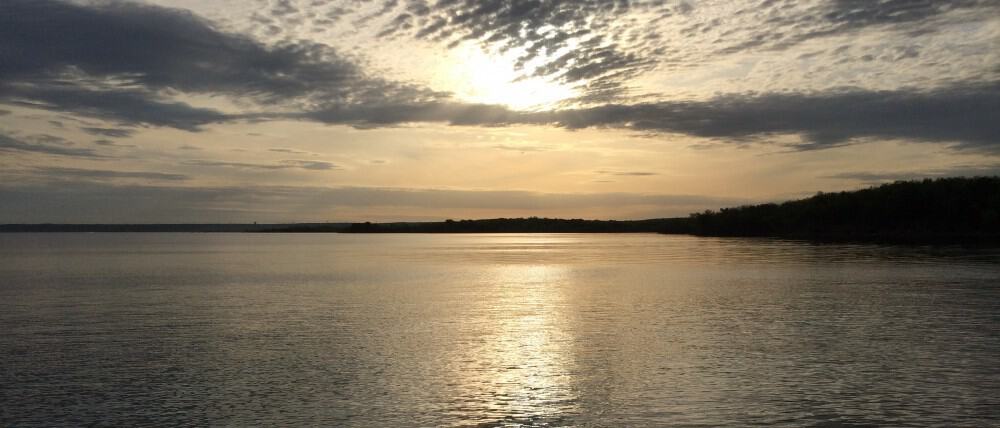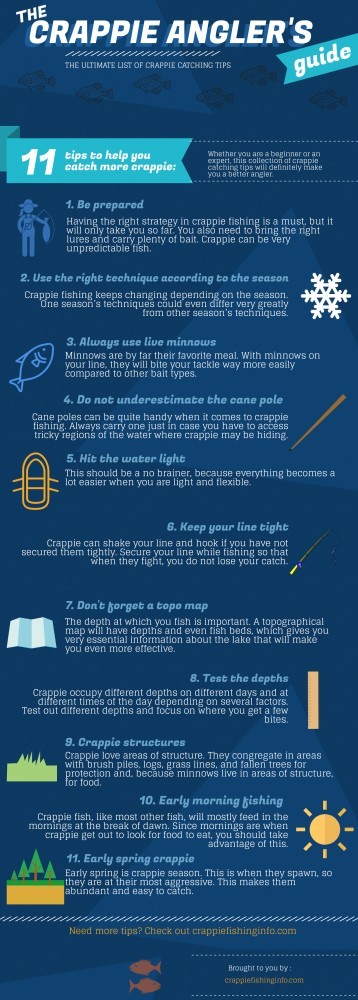Crappie fishing is one of those timeless simple pleasures that generation after generation of anglers get to enjoy. It is perfect for beginners and experienced anglers alike, and the fact that crappie are one of the tastiest pan fish only serves to make it even more perfect.
However, if not done right, crappie fishing can be quite frustrating. Some of the common problems that newbie anglers encounter are bites that won’t grip or catch on, inaccessible cover, and crappie that won’t get what they throw. There is nothing as demoralizing as heading home empty-handed after a long day out in the water.
If you have been having problems catching your limit lately, you have come to the right place. If you are a newbie who simply wants to brush up on some tips for the next time you head out, you are in the right place too. Here is a collection of crappie catching tips that will definitely make you a better angler.
1. BE PREPARED
Having the right strategy in crappie fishing is a must, but it will only take you so far. On top of this, you need to carry the perfect lures and plenty of bait. Crappie can be a very unpredictable fish. What works for them today may not work tomorrow. For example, the plastics you caught your limit with last week might not yield anything today. Which is why it is very important to go prepared and carry lots of lures in different colors, shapes and sizes. This will increase your chances of catching the crappie.
Need to brush up on crappie fishing? Here is an article about crappie fishing basics
2. USE THE RIGHT TECHNIQUE DEPENDING ON THE SEASON
Crappie fishing keeps changing depending on the season. One season’s techniques could even differ very greatly from other season’s techniques. For example, crappies come close to the shores around spring when they are spawning, so their depth at this time makes a fly tackle and ultralight spinning useful. For most of summer, winter and fall, they stay offshore in the deep, so trolling and drifting are useful at that depth.
3. WHATEVER THE SCENARIO, ALWAYS USE LIVE MINNOWS
Saying that crappies like live minnows is a gross understatement. Minnows are by far their favorite meal. With minnows on your line, they will bite your tackle way more easily compared to other bait types.
Some anglers may try to convince you that other small fish like mosquito fish or even mollies work just as well. This is not true. Any angler worth his salt knows that nothing works better than live minnows.
Be sure to use live minnows. Crappie are attracted to movement, so they will ignore dead bait. When hooking your minnows, do it through their nostrils, through the dorsal fin, or through the tail. This will allow them to still move about in the water, making you even more effective.
4. DO NOT UNDERESTIMATE THE CANE POLE
Nowadays, so many people underestimate cane poles, probably because they were used in the past and they are no longer in with the times. But the truth of the matter is, cane poles are quite handy when it comes to crappie fishing.
You should always carry one because they help a lot, especially in unforeseen circumstances. A good example of this is when you come across a spot that is perfect for crappie, but it just happens to be on the other side of a fallen tree. In this scenario, a cane pole is the perfect tool for the job because it will allow you to reach the other side of that tree to get to the crappie hidden there.
What many anglers do not know is that cane poles have become modernized these days. They are now made to retract into smaller, compact sizes. They are also constructed with high quality materials and will fit perfectly into any and all boats.
5. FISH LIGHT
As an angler you also want to sail light. This should be a no brainer, because everything becomes a lot easier when you are light and flexible.
The standard weight for an ultralight tackle is about 2-6 pounds. An ultralight tackle is perfect for crappie fishing and works really well for shallow water, especially in spring during spawning.
This light line allows anglers to cast any small lures or jigs needed for catching fish at far distances. Light lines are also more sensitive so you’ll have a greater chance of feeling the slightest bites from the fish.
6. KEEP YOUR LINE TIGHT
Crappie can shake your line and hook if you have not secured them tightly. Like any other fish or animal, they really fight before they can be put down. It is important to secure your line while fishing so that when that fight happens, you do not lose your catch. Tightening your line is not a hard task, so make sure you remember to do it before you hit the water.
7. NEVER FORGET A TOPOLOGICAL MAP
The depth at which you fish is important in crappie fishing. This is why a topological map of the lake is so important. The map will have depths and even fish beds, which are sunken structures in the lake that you might want to know about.
There are many places that you can obtain such maps, but the best place is the internet. Topological maps can be downloaded for free online.
While at it, you should also keep your fishing electronics close to you. They are more exact since they can pinpoint where fish are.
8. TEST THE DEPTHS
From spring to fall, crappie occupy different depths on different days or times of the day. They do so depending on the temperature of the water, oxygen concentration, bait abundances, among other factors. To determine the depth at which they are swimming, you can use a rod with bait. Simply vary the rod at different depths to find the crappie fish.
In this article titled “how do you catch crappie” I cover depth in tip #5!
9. CRAPPIE STRUCTURES
Crappies love areas of structure. During spawning, they come to the shallow parts of the lake and build their nests around structures like grass lines, rocks, lily pads, and even logs. The same thing happens when they are offshore; they stay around logs and rubles deep in the lake.
Crappie fish will also settle in piles of brush put out by other species of fish. Some wildlife agencies also put piles of brush in the water to attract fish. Such places make the perfect crappie fishing spots.
10. GO CRAPPIE FISHING DURING EARLY MORNINGS
Crappie fish, like most other fish, will mostly feed in the mornings at the break of dawn. Since mornings are when crappie get out to look for food to eat, you should take advantage of this as an angler. Get to them while they are hungry and aggressive and you will catch your limit in no time.
11. CRAPPIE GET OUT AND ABOUT IN EARLY SPRING
Early spring is crappie season. This is when they spawn, so they are at their most aggressive. All the crappie that were deep in the lake, come to the shallows where the males build nests and the females lay eggs. This happens in as shallow as 1 to 6 feet of water where there is a lot of structure.
What this means is that crappie are most abundant and easiest to catch in early spring. This is when you have the highest chance of catching your limit.
I have written a lot about spring crappie fishing. Here are a few posts that you may find interesting:
Spring crappie fishing techniques
DO YOU KNOW HOOK AND LINE BASICS?
As a crappie angler, you also need to know that crappie have very tender mouths. Therefore, you need to go for hooks and lines that are more forgiving to the fish.
Crappie are also not that heavy, so you don’t need very heavy gear for a catch.
When it comes to the choice of hooks, go for larger hooks. Crappie fish have large mouths which are paper-thin, so go for hooks that are larger than #6 up to #1. For big minnows, you can use size 2/0 or 1/0.
In fact, here is an article I wrote specifically about crappie hooks. I hope you find it helpful!
DON’T FORGET THE JIG
This is yet another great tip for increasing your chances at catching crappie. Jigs are versatile in the sense that they allow you to match color, size, or your lure’s action to the angling conditions.
Whether you are fishing in weed beds or using a slip float above brush piles when retrieving past piles, and even when spider rigging, a jig will not let you down.
Natural color jigs are best for clear waters while brightly colored ones are good for muddy, murky water or at night where crappie fish can see them well. Jigs also have Day-Glo options.
RIG LIKE AN EXPERT
Rigging a jig is a simple task, but it is not to be underestimated because it can affect your entire fishing experience. The way you do it is what makes it effective.
Your jig should sit horizontally, or close to it. This way, the crappie will see it as prey. When jigs are vertical, they are not as effective since the fish don’t see them as prey.
Also, note that minnows do not show themselves vertically. The head should not be up and tail down. Try to make a knot position with your jig so the fish can attack it.
GO SLOW ON THE CRAPPIE
When you are out in the lake, what you are essentially looking for are ambush predators for your bait. That’s right: crappie ambush their prey when they hunt. They are hyper-efficient hunters that do not chase their prey.
Therefore, this includes the lures that you cast. Which is why it is good to take things slow; let the lure sink in slowly and wait for the attack. Patience is the name of the game. If it is taking too long to catch one, slow down; your fishing might be too fast.
FINAL THOUGHTS
Here is a pretty cool infographic if I may say so myself! It puts all the info in this article in a nice and neat format for easy review. Feel free to share it with your fishing buddies on social media!
Crappie are a popular game fish for many reasons. They are fun to catch and delicious to eat. However, sometimes, they can be quite tricky to catch. Which is why having a few tricks up your sleeve can go a long way in helping you catch your limit every time.
The best part about crappie is that they can be caught all year long. However, if you want to be able to catch them any day at any time, you need to know your stuff really well. Crappie fishing is a skill like any other, so it takes a bit of practice to become an expert at it. So keep at it!
I hope you enjoyed this article. Do you have any other tip to add? Please leave it below!
Good Fishin’
Mike Aha







